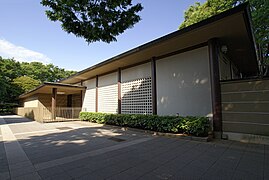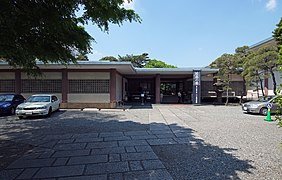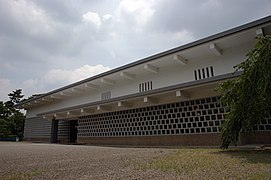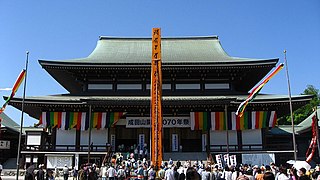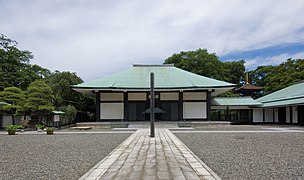Yoshida Isoya
Yoshida Isoya ( Japanese 吉田 五 十八 ; born December 19, 1894 in Toyama Prefecture ; died March 24, 1974 ) was a Japanese architect of the Taishō and Shōwa periods .
life and work
Yoshida Isoya was born as the 5th son of the drug manufacturer Ōta Nobuyoshi (太 田信義). Since his father was 58 years old, he was given the first name "58", not "Gojūhachi", but "Isoya". He was adopted by his mother's brother and has been called Yoshida ever since.
Yoshida Isoya graduated from the "Tōkyō Bijutsu gakkō" (日本 美術 学校), the forerunner of today's Tōkyō Geijutsu Daigaku . In 1925 he and his brother toured Europe for a year, where he was fascinated by traditional western architecture. He therefore made it his business to modernize the traditional Sukiya style for residences. He also applied new technologies to the details of traditional structures and achieved remarkable results. So he introduced the "Ōkabe" (大 大) construction, which hides pillars in the walls and thus creates free space.
During the renewed interest in Japanese style in the 1950s, Yoshida became famous for perfecting the "modern sukiya" and for his residences built under this motto. His work includes houses, Japanese-style restaurants, and museums. Examples are the residences for Yamagata 1956 and Umehara Ryūzaburō 1958, for the restaurant Shinkiraku (新 喜 楽) 1962 and the museums Yamato Bunkakan (大 和文 華 館) 1960 and that for Kawai Gyokudō (川 合 玉堂 美術館), 1961.
Yoshida received the Japanese Academy of Arts Prize in 1952 and the Order of Culture in 1964.
photos
Main hall of the Narita-san
Individual evidence
literature
- S. Noma (Ed.): Yoshida Isoya . In: Japan. An Illustrated Encyclopedia. Kodansha, 1993, ISBN 4-06-205938-X , p. 1756.
- Tazawa, Yutaka: Yoshida Isoya . In: Biographical Dictionary of Japanese Art. Kodansha International, 1981. ISBN 0-87011-488-3 .
| personal data | |
|---|---|
| SURNAME | Yoshida, Isoya |
| ALTERNATIVE NAMES | 吉田 五 十八 (Japanese) |
| BRIEF DESCRIPTION | Japanese architect |
| DATE OF BIRTH | December 19, 1894 |
| PLACE OF BIRTH | Toyama prefecture |
| DATE OF DEATH | March 24, 1974 |

